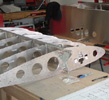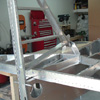


random user submitted photo
Cross-country with two aboard: Tricks for making it work?
15 posts
• Page 2 of 2 • 1, 2
Re: Cross-country with two aboard: Tricks for making it work
Dale,
That's an interesting project you've got there.
I'm sure you know this, but for other folks just joining in: It's important to subtract the weight of the wings before comparing loadings. So, a 950 lb Sonex (max aerobatic weight) - 106 lbs (approx weight of both wings) = 844 lbs of fuselage weight loaded on the wing spars.
At +6 G, that gives 5064 lbs
At -3 G, that gives (-) 2532
If our plane weighs 1250 lbs and the wing weight is the same (106 lbs), then we have 1144 lbs of fuselage weight loaded on the wing spars. If we consider the aerobatic loads above as the upper limit of what we should plan for (950 lb airplane, +6, -3G), then with this 1144 lb fuselage weight we can expect to go to 4.4+ and 2.2-.
There's much more to determining the safe MTOW of a Sonex, but I agree with you on the math.
That's an interesting project you've got there.
I'm sure you know this, but for other folks just joining in: It's important to subtract the weight of the wings before comparing loadings. So, a 950 lb Sonex (max aerobatic weight) - 106 lbs (approx weight of both wings) = 844 lbs of fuselage weight loaded on the wing spars.
At +6 G, that gives 5064 lbs
At -3 G, that gives (-) 2532
If our plane weighs 1250 lbs and the wing weight is the same (106 lbs), then we have 1144 lbs of fuselage weight loaded on the wing spars. If we consider the aerobatic loads above as the upper limit of what we should plan for (950 lb airplane, +6, -3G), then with this 1144 lb fuselage weight we can expect to go to 4.4+ and 2.2-.
There's much more to determining the safe MTOW of a Sonex, but I agree with you on the math.
Mark Waldron
Sonex 1230 (Builder: Jay Gibbs)
Aerovee, Trigear
Sonex 1230 (Builder: Jay Gibbs)
Aerovee, Trigear
- vigilant104
- Posts: 265
- Joined: Wed Nov 09, 2011 3:34 pm
- Location: Near Dayton, OH
Re: Cross-country with two aboard: Tricks for making it work
vigilant104 wrote:To derail my own thread:
The math shows you might be okay on the LSA stall specs at higher gross weights. The Sonex literature indicates a clean Sonex weighing 1100 lbs stalls at 45 MPH. If that's right, then the same Sonex weighing 1200 lbs would stall at 47 MPH. This meets the LSA criteria of a clean stall speed no higher than 51 MPH (45 KCAS).
The formula is:
Vs new = Vs old weight x √(new weight / old weight).
So,
Vs (at 1200 lbs) = 45 x √(1200/1100).
Vs (at 1200 lbs) = 45 x 1.0445
Vs (at 1200 lbs) = 47.0025
I’ve run similar numbers and agree with the math, but one of two factors seem to be at work here – either the Sonex wing is achieving a 3D CL close to or equaling what the 64-415 2D CL is in a wind-tunnel (depending on which spreadsheet I use, that’s in the neighborhood of a 1.72-1.80 CL for the un-flapped Sonex 98 sq.ft. wing – impressive), or the fuselage is indeed acting like a lifting-body and contributing noticeably at low speed. Similar discussions pop up over in the Tailwind forums and it is clear that most there follow the latter notion, and I believe the CAFÉ study supported this although it has been a few years since I read it – I’ve been fascinated with low-aspect lift for some time, so this makes sense to me (demented though it may prove to be…).
Although lifting-body seems to be the prevalent lingo, the actual term might be closer to blended-wing when viewed in the totality, but whatever the case it seems likely to me that (1) the Sonex numbers are real enough and (2) the fuselage is contributing… but for now I’m mentally erring on the side of safety – hence my reservations about declaring above 1150 or so – or at least until the FAA has a track record of accepting those -- of course never having built one (or finished anything much more complex than a birdhouse yet) I'd take my musings with a grain of salt... ;)
-- Larry
-- Larry
Sonex Plans #1621
Sonex Plans #1621
- dcstrng
- Posts: 29
- Joined: Tue Apr 30, 2013 9:55 am
Re: Cross-country with two aboard: Tricks for making it work
Mark,
I'm not the sharpest tool in the shed and math isn't my forte but for as much as I can gather, the math says the Sonex at 1250 lbs gross is LSA compliant and safe. Everyone that has flown it at a gross of 1250 says that the flight characteristics are typical Sonex and that any difference is found in low speeds i.e. take-offs and landings. A number of Jabiru 3300 planes have the gross set at 1250.
There have been many "Cleanex" aircraft built. I'm aware of about a dozen with the most notable being the two that Dan Weseman and Chris Smith built. William Wynn, "The Corvair Authority" told me that he believes the Sonex air frame is the best match he has seen for the 3.0 Corvair. I've seen a number of aerobatic routines (positive Gs only) flown in Corvair powered Sonex aircraft. I personally seen a beautiful Corvair/Sonex that had a lot of extras. I asked the owner of the empty weight. He said 840 lbs. He couldn't remember where he set the gross or was not wanting to reveal that information. I would not do or recommend that!
Personally I believe 1250 Is the limit for a Sonex. I would have set mine lower if needed but the math all seemed to settle in at 1250 lbs for LSA so that is where I set it. I love flying it and so far the flight testing proves it to be stable ... and able! She is quick and nimble.
Thanks for the feedback. I don't discuss this on Sonex forums as the Corvair is not approved by them and I have no intention of poking a bear with a stick. 8~)
Dale
N319WF
PS: BTW, for those that truly believe a Jabiru 3300 FWF package installed weight is less than 200 lbs ... I have some mountain range property in the Florida everglades that you may be interested in looking at. 8~)
I'm not the sharpest tool in the shed and math isn't my forte but for as much as I can gather, the math says the Sonex at 1250 lbs gross is LSA compliant and safe. Everyone that has flown it at a gross of 1250 says that the flight characteristics are typical Sonex and that any difference is found in low speeds i.e. take-offs and landings. A number of Jabiru 3300 planes have the gross set at 1250.
There have been many "Cleanex" aircraft built. I'm aware of about a dozen with the most notable being the two that Dan Weseman and Chris Smith built. William Wynn, "The Corvair Authority" told me that he believes the Sonex air frame is the best match he has seen for the 3.0 Corvair. I've seen a number of aerobatic routines (positive Gs only) flown in Corvair powered Sonex aircraft. I personally seen a beautiful Corvair/Sonex that had a lot of extras. I asked the owner of the empty weight. He said 840 lbs. He couldn't remember where he set the gross or was not wanting to reveal that information. I would not do or recommend that!
Personally I believe 1250 Is the limit for a Sonex. I would have set mine lower if needed but the math all seemed to settle in at 1250 lbs for LSA so that is where I set it. I love flying it and so far the flight testing proves it to be stable ... and able! She is quick and nimble.
Thanks for the feedback. I don't discuss this on Sonex forums as the Corvair is not approved by them and I have no intention of poking a bear with a stick. 8~)
Dale
N319WF
PS: BTW, for those that truly believe a Jabiru 3300 FWF package installed weight is less than 200 lbs ... I have some mountain range property in the Florida everglades that you may be interested in looking at. 8~)
-

daleandee - Posts: 877
- Joined: Fri Feb 01, 2013 6:14 pm
Re: Cross-country with two aboard: Tricks for making it work
Dale,
What is your installed weight on you corvair with prop, oil cooler, ect?
What is your installed weight on you corvair with prop, oil cooler, ect?
- GhostRider32
- Posts: 8
- Joined: Tue Nov 05, 2013 1:06 pm
Re: Cross-country with two aboard: Tricks for making it work
GhostRider32 wrote:Dale,
What is your installed weight on you corvair with prop, oil cooler, ect?
I have no idea. The oil cooler is part of the engine weight. The engine is 218 lbs and my empty weight (before paint) was 726. Dan Weseman came in at 699 lbs but later (I guess after some changes) reported his at 725. Chris Smith was likewise and he, like myself ended up in the 740 lbs range for empty weight after paint. I set and tested to 1250 lbs. I learned recently that a Cleanex has been flown over 1300 lbs with no concerns but I'm not going there. I also know of one Corvair/sonex with an empty weight of 840, but again ... I ain't going there.
Dale
N319WF
-

daleandee - Posts: 877
- Joined: Fri Feb 01, 2013 6:14 pm
15 posts
• Page 2 of 2 • 1, 2
Who is online
Users browsing this forum: No registered users and 80 guests







